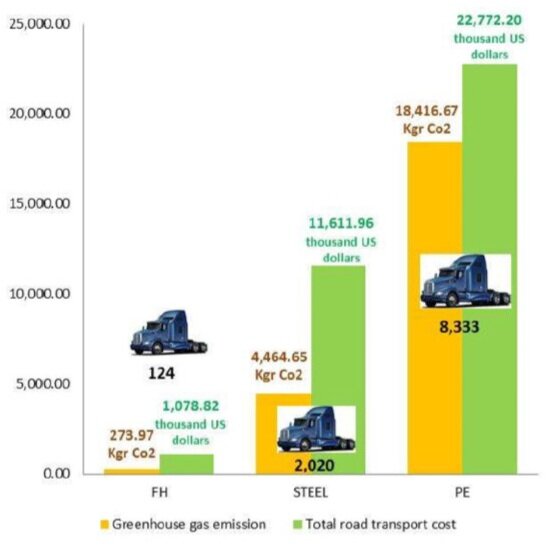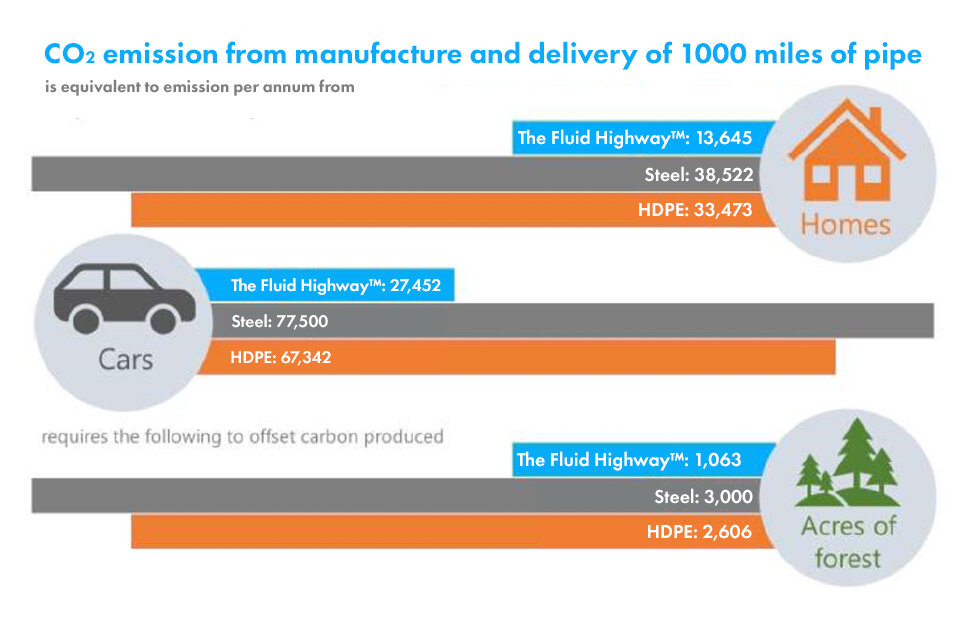The protection of the environment is a key focus for Long Pipes.
Long Pipes is committed to the development of a technologically advanced business that minimises environmental impact in the manufacture, deployment, construction and operation of the Fluid Highway®.
In addition, the technological advances of the Fluid Highway® product mean that it can potentially be used to convey fluids more efficiently, effectively, and safely than existing pipeline products. This provides the opportunity to unlock applications and practices which have until now been impractical, directly contributing to improved sustainable practices and thus providing a positive contribution to the end users license to operate.
As part of this commitment, in 2015 Long Pipes commissioned the University of Sydney to carry out a study titled “Environmental Assessment of Different Long-Distance Water Transportation Schemes”. The objective of this assessment was to compare the environmental impact and carbon footprint of pipes made of three different materials
The Fluid Highway®-composite material
Steel
Polyethylene pipes (HDPE)
The study looked at the carbon footprint for the production of 600km (16 bar pressure) pipe using the 3 materials. The results of the comparison show that steel pipe emits 3 times as much carbon as the Fluid Highway® and HDPE emits 2.5 times s much carbon as the Fluid Highway®
FINAL PRODUCTION CO2 FOOTPRINT RESULTS
The study captured all aspects of a pipeline project including manufacture and transport of the raw materials, the pipe manufacture, pipe delivery to site, the construction of the pipeline and the operation of the pipeline. A significant factor in The Fluid Highway® having such a reduced overall environmental impact is due to the logistics of transporting the pipes to site via trucks. The Fluid Highway® required 565 truckloads for the sock, resin and equipment delivered to site compared to 4900 trucks of HDPE pipes and 2240 trucks of steel pipes delivered to site.
The three pipes assessed for this study all had similar internal diameters but the masses of both the steel and HDPE pipes were 5 times that of the the Fluid Highway®.
The picture below shows that for the same internal diameter the steel pipe has the same wall thickness but the steel density means it is 4 to 5 times heavier than the Fluid Highway®. The HDPE pipe has to be very thick to achieve the same strength as the Fluid Highway® but is also 4 to 5 times heavier.
With this key advantage in mind The University of Sydney study compared the transport costs and kilograms of CO2 emitted to lay 600kms of pipe.
COMPARISON GRAPH BETWEEN THE AMOUNT OF GREENHOUSE GAS EMISSIONS AND THE ECONOMIC VALUE TO LAY 600KM OF PIPE
Comparison graph between the amount of greenhouse gas emissions and the economic value
When combining the lower carbon footprint from both the production and delivery of the Fluid Highway® the environmental impact is significantly reduced compared to comparable steel and HDPE products and can be represented by the chart below:
Where the Fluid Highway® is manufactured in standard 50ft lengths and transported to site it requires considerably fewer trucks, due to its significantly lower weight, than comparable steel and HDPE pipes. For the same flow performance, for 300 miles of pipe, only 683 trucks would be required to transport the 12.75 inch Fluid Highway® pipe
to site whilst 1367 trucks would be required for the 16 inch HDPE equivalent and 937 trucks to transport the steel pipe.
This is demonstrated in the tables below:
Notes:
The 324 mm Fluid Highway® is equivalent in flow to a 406 mm HDPE SDR9 pipe for the same operating pressure. The 406 mm HDPE needs twice the number of trucks for transport and produces twice the quantity of CO2 compared to the 324 mm Fluid Highway™ pipe.
The Fluid Highway® 324 mm has a larger flow rate than a 508 mm HDPE SDR9 when derating of HDPE for temperature and hydrocarbons is included. The 508 mm HDPE needs 2.8 times the number of trucks for transport and produces 2.8 times the quantity of CO2 compared to The 324 mm Fluid Highway® pipe.
Carbon Dioxide emissions from University of Sydney Report commissioned by Long Pipes.
When factoring in the amount of liquid that can be transported through The Fluid Highway® compared to HDPE and Steel equivalents, which need to have a much larger outside diameter to carry the equivalent amount of fluid, then the superior characteristic of The Fluid Highway® are clearly demonstrated with tonnes of CO2 per year/ML being less than one half and up to almost one third of competitor products.
Notes:
The CO2 emissions are based on the University of Sydney Report for The Fluid Highway®, steel and polyethylene pipe (HDPE). In this report the outside diameters were 610 mm for The Fluid Highway®, 610 mm for steel pipe and 800 mm for HDPE.
The CO2 emissions were calculated based on the manufacture and delivery of each pipe type for a 600 km long pipeline.
It is assumed epoxy lined steel, The Fluid Highway® and HDPE have similar coefficients of friction.
The inherent qualities of the manufactured pipe also provide a range of additional environmental and safety benefits when compared to steel and polyethylene pipes.
When manufactured in the field the raw materials used to produce The Fluid Highway® pipe are transported to site in containers, which do not roll off trucks like pipes do. The Fluid Highway® is also 75% less weight than a steel pipe of the same performance making the risk of injury far lower.
In addition a pipe rupture or damage to The Fluid Highway® pipe at a specific point should not result in a catastrophic failure. Normally, when the steel pipe is damaged under pressure the fracture/crack ruptures across the pipe or the crack can run for many kilometers along the pipe producing sparks, and potentially posing a fire risk. The steel industry employs fiberglass bands at various intervals to stop this event.
Gas leakage is a significant issue in long distance gas piping especially if the gas is a greenhouse gas. Steel pipe can leak through the micro cracks at the welded joints, and the micro cracks continue to form as the pipe heats and cools. The Fluid Highway® has been tested with its highly impermeable plastic internal liner to show it greatly restricts gases such as hydrogen and carbon dioxide from permeating though the pipe walls. This can result in a substantial reduction in greenhouse gas emissions and provides substantial opportunities for Long Pipes in the future.
Long Pipes is confident that The Fluid Highway® can become the preferred means of transportation for hydrogen as the move towards a hydrogen-based economy gathers pace. By using The Fluid Highway® pipes that are specifically created to be impermeable to hydrogen this would make it the pipe of choice for hydrogen transportation.





